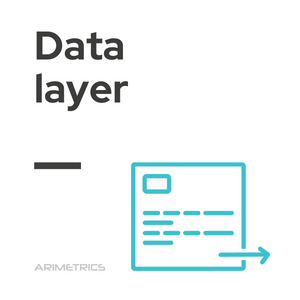
Definition:
A data layer is an object that contains all the information you want to pass from your website to a tag manager (for example, Google Tag Manager).
The data layer acts as a bridge between the website and other linked applications, enabling the transfer of information in a coherent and consistent manner. Its use is essential to decouple semantic information from other data stored in the digital context, facilitating clearer and more orderly data management.
The dataLayer of Google Tag Manager
The integration of the datalayer with Google Tag Manager maximizes the capabilities of GTM, as it allows to store in a structured way all relevant website information to be shared with tags. This data structure can contain:
- Static information: Data that does not depend on the architecture of the website or the actions that occur on it, such as the category of a page or the type of user.
- Dynamic information: Data linked to specific actions or transactions, such as user interactions, that are crucial for advanced analytics processes.
By using a data layer, greater flexibility and accuracy in tracking and analyzing user interactions is achieved, facilitating data-driven decision making.
Examples of Data Layer:
Information about the page, such as category, or type of visitor, can be saved in the data layer:
dataLayer = [{
'categoria': 'login',
'tipoUsuario': 'top'
}];
You can also save the interactions that happen on that page, through the dataLayer.push command.
For example, suppose a user enters certain information into a form, such as the city where they reside, something you want to track with a label in the container. You can add this data to the data layer instantly using a simple command.
dataLayer.push({
'ciudadResidencia': 'Madrid',
});
Advantages of Datalayer
Among the advantages of using a data layer we can highlight:
- Data standardization: The data layer provides a standardized format for data collection and transmission, ensuring consistency and ease of interpretation.
- Flexibility and scalability: Allows tracking changes without modifying the site’s code, facilitating scalability and quick adaptations to new needs.
- Improved Data Accuracy: Centralizes data management, reducing the risk of errors and duplications, thus improving the accuracy of data collected.
- Facilitates collaborative work: A well-defined data layer improves communication between marketing, development and analytics teams by ensuring that everyone is working with the same base information.
- Performance optimization: Sends data directly to the tag manager, minimizing the browser’s workload and optimizing website performance.
- Improved user experience: Enables more accurate and personalized tracking of interactions, creating more relevant and engaging experiences for visitors.
